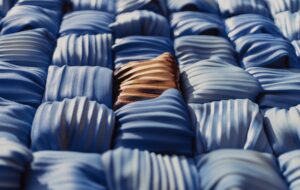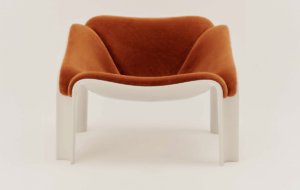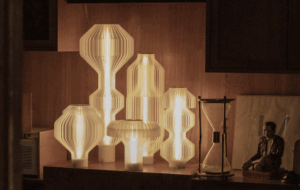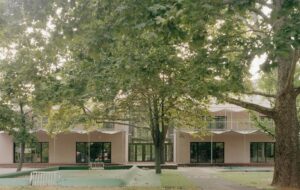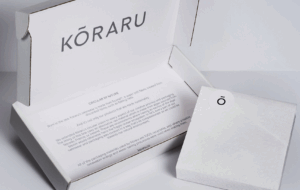

words Justin McGuirk
A retrospective of the work of the Italian collective Superstudio looks at how they took the logic of modernist rationalism to its absurd end. But how serious were they?
You could understand it if the crowds drooling over the Manolo Blahnik exhibition at the Design Museum viewed the Superstudio retrospective upstairs with a suspicious eye. If the architectural collective’s perverse vision had been realised it would have left no place for one man to design all those shoes. In fact, designers would have been out altogether. In this respect, “Life Without Objects” is quite a useful title for an exhibition of Superstudio’s work, in that it offers those unfamiliar with it an instant clue to the kind of rhetoric that lay behind such aggressively uncompromising architecture. The difficult thing about Superstudio is knowing just when they were being serious.
Superstudio was founded in 1966 by Adolfo Natalini and Cristiano Toraldo di Francia – two young architecture graduates from Florence University who had just collaborated on an exhibition called “Superarchitecture”. Within two years they had been joined by fellow graduates Gian Piero Frassinelli and Alessandro and Roberto Magris. The drawings and collages of this Florentine nexus are unmistakably the product of the late 1960s – and not just because its members appear in the foreground now and then wearing fur coats and moustaches. In Italy, as elsewhere in Europe, student activists were railing against “the system” and the idea of the manifesto seemed suddenly to have some life left in it. The system as Superstudio saw it was an entrenched modernism foundering in its so-called rationalist and functionalist impulses and a slave to consumer society.
Borne along by a fashionable Marxist undercurrent, Superstudio developed an extreme aesthetic that looked like modernism run wild and yet purported to offer an egalitarian utopia freed from the cycle of consumption. But Superstudio’s designs, like those of its counterpart group Archizoom, were not blueprints for a buildable future. Superstudio never built anything – not as a collective, anyway. Like the cartoon fantasies of Archigram, which were a major influence on the group, Superstudio’s designs belonged to a discourse that was self-consciously innovative and confined to architecture magazines and exhibitions.
That the group should have a retrospective in London now is largely because the Design Museum is making a necessary stop on its tour of influential Italian designers, following on from Memphis in 2001 and Gio Ponti in 2002. However, if there is a particular relevance it is that Superstudio made a distinct impression on a generation of architects – including Rem Koolhaas, Zaha Hadid, Bernard Tschumi and Nigel Coates – who were exposed to their ideas at the Architectural Association in the late 1960s and early 1970s and who have now come of age. Koolhaas’ final-year project at the AA, Exodus (1972), is so derivative of Superstudio’s Continuous Monument that one can chart the architect’s fascination with social and cultural systems back to that point.
Superstudio’s Continuous Monument, developed in a series of collages and storyboards in 1969, is a vision of total urbanisation. There is nature and then there is the city, a single giant structure stretching across the landscape. The city’s form is determined by a geometric accumulation of white cubes – and if cities can be achieved simply by multiplying these basic components then there is no need any more for architects. How these megaliths work and what goes on inside them is left to the imagination. As pure surface, however, the Continuous Monument pretends to be deeply rational, and the storyboard text seems to corroborate that. In one image, Manhattan is engulfed by an infinite superstructure, except for “a bunch of ancient skyscrapers, preserved in memory of a time when cities were built with no single plan”.
Superstudio, of course, have a less than reverent belief in their own exaggerated systems. The Histograms, or The Architects’ Tombs (1969) are a series of white-grid models that amounts to a pattern book for freeing up design energy for more socially worthwhile endeavours. But in Ceremony, a film being projected above the models, the group can be seen eating a picnic off one of them. This is all part of Superstudio’s game; their models and drawings are criticism in approval’s clothing.
Superstudio’s images take modernist functionalism to its absurd limit. The Continuous Monument both extends and undermines the supposedly rational systems of Le Corbusier and the International Style. It is dramatic and banal, like a giant inverted bathroom, and it makes one uneasy because we are so clearly subservient to it and because it is so impenetrable. What Superstudio are offering is a spurious utopia designed to make one reflect on how the world could look if the then accepted norms of design and urban planning progressed unchecked.
The problem is that it’s not as simple or coherent as that. Somewhere in there, amid the irony and shock tactics, is a genuine optimism based on a technologically and morally superior future. Superstudio do evidently believe in the egalitarianism of their designs and the potential to move beyond a consumer society. Their idea of a single design anticipates to some extent the cultural uniformity of globalisation and is also a pseudo-practical approach to a world of sprawling cities.
But here again Superstudio present possibilities with a humorous sci-fi foreboding. In Twelve Cautionary Tales for Christmas, a storyboard for a 1971 issue of Architectural Design, they describe 12 “ideal” cities. In City of Order, an Orwellian control is achieved over the citizens by dint of either torture or brainwashing: if a citizen deviates or complains, “he is sent to the town hall where he will be a guest for a week, and convinced”. Even more disturbingly, in New York of Brains, an explosion has left a “charred, devastated” city of contaminated citizens. The solution? A city-sized cube to serve as an eternal life-support machine for 10,000,456 brains.
Like Archigram, Superstudio gave free rein to their imaginations. Their brain city is quite a good joke as a play on the Corbusian “machine for living”. It’s up there with the group’s 1972 plan to make all the buildings in Pisa lean, except for the tower. The point is, in more or less a single frustrated gesture, Superstudio had done away with architecture, and so increasingly their work became fiction. They could afford to be playful, and even to attempt to be prescient, because they weren’t being commissioned to build anything. When, in the late 1970s, work started to come along, that was the end of Superstudio.
Superstudio: Life Without Objects, Design Museum, London, www.designmuseum.org, Until June 8 2003






